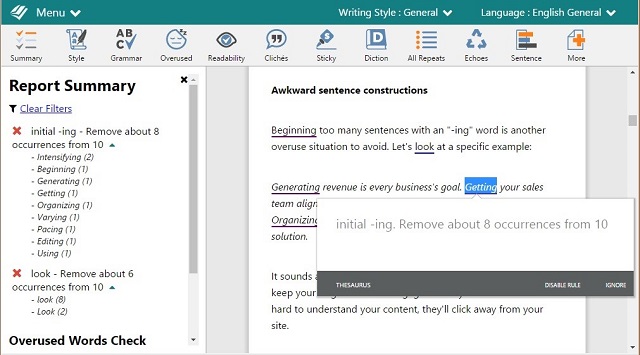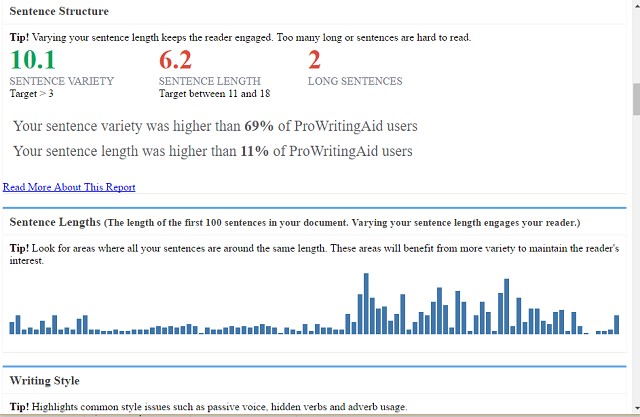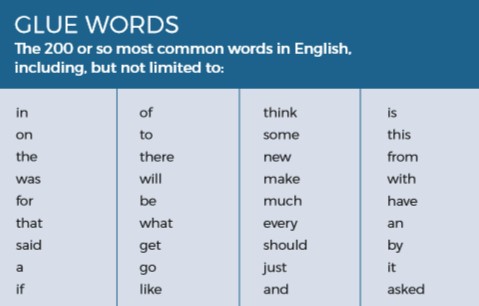
Consider the content on your website and in your blog posts, the product descriptions in your eCommerce store, your lead generation pieces, and your emails. Every word makes an impression on your customers and prospects. Small businesses with remote workers around the world don't have a brick-and-mortar shop. So the face you put forward in your content should represent your company well.
If your content is rife with punctuation and spelling errors, technical gaffes, or vague wording, what impression does that send?
Here are 10 ways to make sure your content is concise, technically accurate, and clearly understandable so your potential customers focus on your product's or service's benefits instead of bad writing. Most of these issues can be easily caught by an editing tool like ProWritingAid, others require vigilance on the part of the writer.
1. Overused words
Some words and phrases are fine to use every once in a while, but when overused tend to detract from your meaning or come off as too awkward or wishy-washy. Let's look at a few examples.
"Could," "might," and "maybe"
When you overuse these words, you sound unsure. "I might get this report done by Jan 18th" or "Maybe I could send you a sample" tell your reader you're uncertain.
The solution is to use authoritative phrasing. "I will have this report done by Jan 18th" and "I'll send you a sample" tell your target audience that you mean what you say. If you want to engender trust, avoid undefined words and opt for a clear, exact statement instead.
Intensifying words
Intensifying words are crutches for weaker words. When you use "very," "really," and "so" to prop up a weak noun, adverb, or adjective, you're muddying the waters.
If you tell customers that your service is "very fast," just how fast should they assume that means? It's much better to let customers know specifics, such as "we have 24-hour turnaround."
When you come across an intensifier, see if you can replace it with a stronger word. Why say, "We're really happy to have you as a new customer" when you could let your customers know "we're thrilled to partner with you on this project."
Nonspecific words
When you read the statement "I like your new system. I find it an interesting resource," what comes to mind? It could refer to anything, right? A resource could be a book, a tree, or even a person.
Avoid nonspecific words like "interesting," "resource," and "system." Instead, use more concrete wording such as "Your new SaaS platform is amazing. I use it every day to manage my to-do list."
Awkward sentence constructions
Beginning too many sentences with an "-ing" word is another overuse situation to avoid. Let's look at a specific example:
Generating revenue is every business's goal. Getting your sales team aligned with your marketing strategies is a key component. Organizing teams of both sales and marketing personnel is one solution.
It sounds a little robotic. Mix up your sentence constructions to keep your target audience engaged. If they have to work too hard to understand your content, they'll click away from your site.

2. Sentence structure
The length of your sentences matter. Varying sentence lengths between short, long, and medium makes your content flow better for readers. Let's look at a few examples.
Short
The report's due date is Friday. Julie says she is on schedule. We forewarned the copy room. They'll have copies ready by 4pm. Packets will be delivered by 5pm.
Long
Since the client has a concrete deadline of Friday end of day and Julie says she's on schedule, we need the report finalized early on Friday so the copy room can make the copies and put together the packets in enough time for our delivery guy to drop them off at the client's by 5pm.
Varied
The client has a concrete deadline of Friday end of day. With Julie on schedule for completion, we can get the report to the copy room early Friday. This should give them enough time to make the packets. Then our delivery guy can drop off the packets at the client's by 5pm.
It's like Goldilocks and the Three Bears. One is too choppy (short sentences), one is too befuddled (long sentence), and one is just right (varied).
You can use an editing tool to create a visual representation of your text so that you can check your variation. It looks like this:

3. Writing style
Stylistic choices make a dramatic difference in how your customers perceive your company. Plus, search engines look for strong writing and will dock your website for weak writing style. To avoid this, replace instances of passive voice, hidden verbs, too many adverbs, and corporate wording.
A few examples will help define each of these.
Passive voice
Passive voice occurs when the subject of your sentence comes after the verb or is eliminated completely. Here are two sentences using passive voice.
The white paper is being edited prior to publication to catch last minute errors and omissions.
The webinar was created by Tech Support to show attendees how best to handle error reporting.
In the first example, who is editing the white paper is eliminated completely. And in the second sentence, the subject doing the creating comes after the verb.
Now let's look at the same sentences using an active voice:
Janie will edit the white paper prior to publication to catch last minute errors and omissions.
Tech Support created the webinar to show attendees how best to handle error reporting.
Notice how each sentence has a subject followed by an active verb. Passive voice can sound stuffy and politicians use it to avoid taking responsibility for their actions. You want your content to use active voice at all times.
Hidden verbs
Verbs can hide in your sentences when you add "-ion" or another suffix to a verb to turn it into a noun. Again, a few examples will make this clearer.
Our employees took up a collection for the Make a Wish Foundation to help seriously ill children.
We performed an analysis of the machine's components to identify wear and tear.
The executives made a decision to forego company bonuses this year.
Can you spot the hidden verbs in these sentences? Now check out these rewrites:
Our employees collected money for the Make a Wish Foundation to help seriously ill children.
We analyzed the machine's components to identify wear and tear.
The executives decided to forego company bonuses this year.
Adverbs
Used sparingly, some adverbs are Ok. Used to mask a weak verb, however, adverbs are crutches used by lazy writers. Look for a stronger verb instead. Here are some examples:
Weak verb + adverb: The manager quickly sent his response via email.
Strong verb: The manager fired his response via email.
Weak verb + adverb: The CEO spoke eloquently about the company's mission and vision.
Strong verb: The CEO articulated the company's mission and vision.
Corporate wording
Corporate wording creeps into writing when you're more concerned about eloquence than you are clarity. Take a look at this example of corporate wording gone overboard.
- Our latest platform creates synergy between users and administrators to enhance workarounds and generate buy-in for our core competency.
Now read the rewritten version:
- Users and administrators are creating solutions we hope everyone can get behind to support our company's products and services.
4. Sticky sentences
You've probably never heard of sticky sentences, but they're a real problem in writing. Sentences can get sticky when they have too many glue words holding them together. These glue words are 200+ of the most common words in the English language. The following chart shows a few glue words to give you an idea:

Once again, an example will help explain sticky sentences.
- I was able to find the answer to the problem in the database of the audit reports of the system and get the system admin to make some changes that will resolve the issue.
The percentage of glue words used (called the glue index) in the above sentence is 61.8%. You want to shoot for 40% or less. Take a look at the sentence rewritten:
- The audit reports database contained the error, and the system admin's changes resolved the issue.
The glue index for the rewritten sentence is 37.5%, under the 40% recommended.
Using an editing tool to highlight sticky sentences is an easy way to search out awkward and clunky writing. Sometimes a sticky sentence will be fine, but more often than not, it can be improved by breaking it into two sentences or rewording it in a simpler way.
5. Pacing
Pacing refers to the speed that readers move through your content. You'll use pacing differently depending on the purpose of your content.
For example, let's say you're writing a White Paper for customers and prospects to learn more about your products or services. As discussed above, you want to vary your sentence lengths to keep your readers' attention.
But if you're writing web content, you want to use short, punchy sentences that visitors can skim. Be honest: do you read long blocks of content on websites, or do you skip ahead and read the headings?
Visitors to your website want to find the information they need as fast as possible. Give it to them in short, easily-digestible bits of information that anyone can understand at a glance.
A great way to accomplish this is to use headings that move your reader from the top of the page down to the bottom with short one- or two-sentence paragraphs underneath.
Another technique is to use bullet points with short descriptions. Website visitors enjoy lots of white space, images, and videos on websites, so the less text the better. And what you do use, make it short and concise. Make every word count.
6. Transitions
Transitions get little attention, but they're important to help your readers stick with you. Consider them the road signs in your content that help your reader follow your train of thought.
Transitional words and phrases help move your reader through your website, too. You don't want to jump from idea to idea without helping website visitors understand you're covering something new.
You might remember transitional phrases from school, like "as a result," "nevertheless," "likewise," or even "in order to." These phrases show the relationships between your ideas. A few examples will clarify:
The water test kit is composed of 10 different contaminant testing strips. You'll need to send samples to the laboratory for analysis.
The water test kit is composed of 10 different contaminant testing strips. However, you'll need to send samples to the laboratory for analysis.
The second sentence with its transition makes it clear to your reader that these two ideas are separate thoughts that require different actions.
Let's see another transition in practice:
Mark is the senior manager in charge of inbound marketing for the metals and construction group. He covers the cement desk.
Mark is the senior manager in charge of inbound marketing for the metals and construction group. In addition, he covers the cement desk.
In the second sentence, it's clear that Mark's responsibilities on the cement desk are in addition to his senior manager responsibilities, not part of them.
7. Repeated phrases
You may not even notice when you use the same phrases repeatedly in your content. When you're writing, certain words can stay top of mind and spill out frequently.
The following example will shed a little light.
The company's new vision statement identifies opportunities we want to target and where we see ourselves in 5 years. The Board of Directors approved the new vision statement at their regular meeting last month. We're just now rolling out the new vision statement to all employees, but many of you have seen one version or another over the past several weeks.
Did you identify the repeated phrase that kept showing up throughout the paragraph? This technical gaffe can be hard to pick out in your content, so it is helpful to have software that picks up on repeated words and phrases.
The exception to this rule is, of course, keywords. You need to use keywords at a 2.5% density rate throughout your website content for search engines to recognize and rank your site for them. Anything more than 2.5% is keyword stuffing and search engines could penalize your site.
8. Clichés
Clichés can still occur in business writing. In fact, Inc. Magazine has an excellent article titled These 32 Business Clichés Need to Die that everyone should read.
Here's a fantastic example of clichés overdone:
Tom, I need to pick your brain. Let's think outside the box and get disruptive. We're done with the low-hanging fruit; now it's time to raise the bar. Let's take a deep dive and really push the envelope. I want to create a paradigm shift here. Let me know your thoughts.
What is this person trying to say? He/she needs to work on finding fresh ways to communicate, not only because the clichés have been done to death, but because they just don't give specific information. They've lost their impact and meaning. Surely the writer could be more "granular" (that's a cliché for "specific" that also needs to die).
9. Consistency
Your website visitors, customers, and prospects will notice if you're not consistent with spelling, hyphenation, and capitalization. And for remote teams from the US, England, Canada, and Australia, spelling inconsistency happens easily.
There are over 1,700 spelling differences between UK English and US English, and Canadian and Australian English is a somewhere in between the two. The most common inconsistencies are words with "-or" in US English compared to "-our" in UK English, such as honor/honour, color/colour, and neighborhood/neighbourhood. This is just the tip of the iceberg, however. You should pick one version of English—US, UK, Canadian, Aussie, etc.—and stick with it.
Another inconsistency that readers will notice is hyphenation. How many times do you refer to the "long-term" plans of your division or perhaps your company's "long term" plans.
Do you hyphenate "e-mail" or do you use "email"? Inconsistent use of hyphens is a common error; over 60% of randomly sampled documents have some form of hyphenation inconsistency. So, it happens to the best of us.
Finally, capitalization inconsistencies are an easy error to make, too. Do you "google" something or "Google" it? Is it the "Internet" or the "internet"? I've seen these both ways, so again, pick one and stick with it.
10. Vague and abstract words
Unclear words lack specificity and leave your reader wondering. In particular, vague words are too subjective in meaning. Consider "tall," "pretty," "little," "slightly," or "good." What you consider "pretty tall," I might consider average height.
Choose words with stronger denotations to replace vague terms. Here's a fun example.
Your boss writes you an email: I read your report. It's pretty good. Still, can you make it stronger?
How do you respond to that lack of specificity? For remote employees, this vagueness requires a Skype call to clarify, which wastes your time and your manager's. Concise writing doesn't mean you have fewer words, as in the above example. It means you're choosing the strongest words possible to make sure your reader understands your meaning.
I read your report. It's well-written but I wondered if you can add more evidence to back up your arguments in sections four and five. I suggest using the stats from the last quarterly report.
There. Now you know exactly what your boss liked and how she thinks it can be made stronger.
Conclusion
The above examples show "bad writing" that makes your business look unprofessional. Urge your remote staff responsible for content to use an editing tool like ProWritingAid to help them check for technical edits and style choices.
An editing tool makes suggestions for improvement and lets you choose what edits to make. This allows you to keep your brand voice and style consistent.
More importantly, however, your customers and prospects will be more engaged with your content. When visitors are engaged with the content on your website, your conversion rates will increase. And that's what we all want, isn't it?
Don't turn customers away with bad writing. Use an editing tool like ProWritingAid to help you boost your bottom line.


